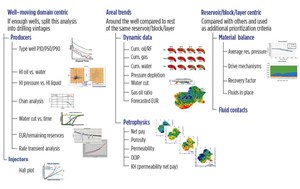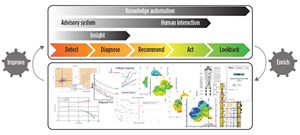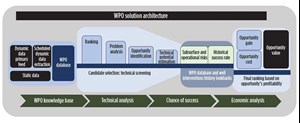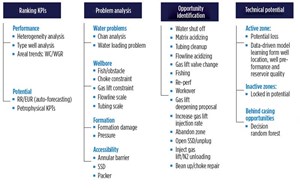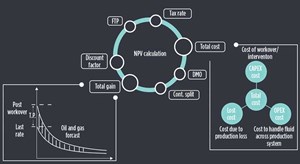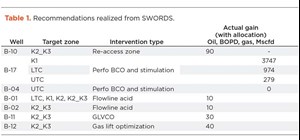Developing a smart workover and intervention strategy, using automation and advanced data analytics
Well workovers and interventions are essential strategies for operators to sustain or increase their production. However, the well review process for these jobs is time-consuming, involving numerous manual and repetitive tasks to gather data and analyze results, resulting in projects taking weeks or even months before getting to the planning and execution stage. In addition, best practices and lessons learned from past interventions are rarely captured, preventing a systematic improvement of the well selection methodology and choice of interventions for future well reviews.
Leveraging automation and advanced data analytics, Schlumberger, working with PT Saka Energi Indonesia (PGN Saka), developed a well optimization solution that not only automated many of the manual data gathering tasks but also the engineering and economic workflows that are used during the pre-planning stage for a well intervention or workover. This has helped PGN Saka’s engineers make more informed decisions faster, resulting in economic production gains.
INDUSTRY CHALLENGE
With oil and gas companies operating under razor-thin margins, production engineering teams are under increased pressure to squeeze production from their existing assets, as efficiently and economically as possible.
A strategic well intervention and workover program can help operators achieve this objective. However, the pre-planning well review process for such jobs, which involves screening wells, selecting the best intervention or workover method, and estimating the post-job value of the well against the cost, is often characterized by inefficiency.
Time-consuming manual tasks, such as gathering historical and offset well data, and running standard petroleum engineering techniques across multiple wells, prevents production engineers from spending more time working on higher-value engineering workflows for planning and execution of a workover or intervention. This considerable time investment also limits the volume of wells that can be evaluated over a given timeframe, resulting in missed opportunities.
Without being able to easily access data or automate low-value tasks for screening wells, production engineering teams are heavily constrained in implementing well interventions or workovers that deliver the maximum economic benefit to their organizations.
CURRENT STRATEGIES
During the pre-planning or candidate screening stage of a traditional well intervention or workover program, production engineering teams use a multitude of applications to collate data, and manual engineering techniques to conduct their well screening and analysis. These analyses are repetitive in nature and limit the extent of study when managing high-well-count assets. Teams traditionally adopt a reactive approach to managing the health of their wells. Figure 1 illustrates the standard methods applied for the candidate selection stage.
Depending on the scope of the project, the realization of the workover or intervention opportunity can take a very long time, sometimes even up to a year. The well screening process alone can take more than three months.
Due to this lengthy timeframe, reviews are generally only performed two to four times per year, and sometimes less, depending on the operator. This results in significant time lags between the time from review to execution in the field. The delay adversely affects the realization of production potential.
SOLUTION
The adoption of various analytics and machine learning tools into engineering workflows, such as regression and classification models, make it possible to automate and improve many of the manual processes that are used in a traditional well workover or intervention programs.
Using these tools, Schlumberger has developed a knowledge-based system (Fig. 2) that provides a standardized, automated approach for the well opportunity maturation process (OMP). The system is based on a hybrid and automated decision-support system anchored in a knowledge-based framework. Hybrid refers to the integration of the petroleum engineering analysis methods and the operator’s business logic with advanced machine learning algorithms, to autonomously identify well performance signature and opportunities that are best aligned with the operator’s economic considerations.
This system can rapidly screen and rank high-well-count assets (hundreds or thousands of wells) in a fraction of the time, compared with traditional approaches. Such a solution enables the proactive management of existing wells by keeping the production enhancement opportunity pipeline full and expediting potential candidates. The system detects, diagnoses and recommends the appropriate actions required to ensure that wells remain healthy. The results captured from the actions can be used to enrich and improve the system.
CASE STUDY
PGN Saka operates the Ujung Pangkah assets, an offshore oil and gas field in Indonesia. Ujung Pangkah field is undergoing a major development that involves well intervention, workover and surface optimization. To boost overall performance across the asset, PGN Saka wanted to uncover opportunities to streamline its well review process.
The main reservoir in Ujung Pangkah field is Kujung 1 carbonate (K1Z2-3), an early Miocene platform margin carbonate reef buildup. It is a multi-layered carbonate reservoir, which produces through multi-lateral wells. Because it is a mature field, the process of selecting wells for production enhancement projects can be tedious and challenging. PGN Saka was using a manual process to conduct its well reviews and relied on each engineer’s individual experience to assess the wells, as most of the best practices and lessons learned from previous projects weren’t captured.
In 2018, a workshop was conducted to uncover solutions that would increase PGN Saka’s hydrocarbon production and reserves in a cost-effective manner, and accelerate recovery and decision-making time. The workshop found that just reviewing the results of the workover candidate program took PGN Saka management around 200 days. Engineers spent another 90 to 120 days conducting a field-wide well review to plan annual workover and intervention campaigns. Because of this significant time investment, PGN Saka only conducted reviews one to two times per year.
To address this issue, Schlumberger, working closely with PGN Saka engineers, developed a well portfolio optimization (WPO) solution termed Saka well opportunity register, define and selection (SWORDS) for the Ujung Pangkah asset. SWORDS is a decision-support advisory system that incorporates decades of proven petroleum engineering analysis methods and best practices, combined with PGN Saka’s business logic, to automatically and autonomously:
- identify underperforming wells through their performance signatures
- determine root causes
- recommend the most appropriate remedial interventions
- probabilistically quantify post-workover production
- evaluate risked economic viability of workover candidates
- estimate the chance of success for each intervention.
The SWORDS solution runs continuously in the background of PGN Saka’s operations, requiring only minimal manual interaction. Thus, PGN Saka’s engineers receive constantly updated insights on the intervention and workover opportunities across the asset. Figure 3 describes the key elements of the advisory system.
The key objectives of the SWORDS solution were to substantially decrease time and effort for well reviews; automate a manual well OMP, in particular the initial candidate screening; increase decision accuracy and quality; and enable PGN Saka to go from reactive “firefighting” mode to a more proactive approach, and shift engineering focus to higher cognitive engineering efforts required for the planning and execution of an intervention or a workover.
The SWORDS design introduced new automation and data analytics technologies and a standard approach to well portfolio optimization for PGN Saka. Working closely with PGN Saka engineers, the following components of the new workflow, shown in Fig. 3, were evaluated to see if they could be automated or improved:
- knowledge base
- technical screening
- ranking (production analytics ranking)
- problem analysis
- opportunity identification
- technical potential or gain estimation
- risk assessment
- historical success
- economic analysis.
Adding a new, robust and integrated database as the knowledge base, which holds all the variables and values needed by the analysis, was critical to ensuring result quality.
Steps two through six, which are the technical analysis workflow components shown in Fig. 3, were modified with the approaches described in Fig. 4. These steps were key to evaluating the quality of candidate wells.
A performance-based initial screening was developed to group wells as under- and over-performers. This screening incorporated multi-level operator KPIs (well, aerial and field level) to compute candidate scores, using multi-criteria decision-making analysis techniques.
At the problem analysis stage, the goal was to identify whether any constraints existed in the well at any level, including at the completion or the wellbore level. This analysis was heavily dependent on deploying analytics to diagnose the well problems. For example, Chan analysis was deployed to determine the root cause of high water production.
At the opportunity identification stage, the goal was to identify the workover or intervention opportunities that could be implemented in the candidate well to solve the highlighted problems and improve the production. This was based on a problem-opportunity logic set driven by WPO solution components like reserves and analytics signatures.
For the technical potential or gain estimation stage, data-based models estimated how much production could be improved in the candidate well, and, when applicable, found the deliverability of new zones that could be opened in a well.
Using the data from producing completions, a decision random forest model was deployed to determine the potential of virgin reservoirs and recommend new completions. The unproduced zones were identified as “behind-casing opportunities.”
The technical potential was based on automated forecasting. There were ways to improve current practice by creating automated forecasting and accessing completion level analysis. Prior to SWORDS, forecasts were done at the string level. While string-level forecasts are not uncommon, it doesn’t take zonal performance into account. It was, therefore, recommended to forecast at the completion level using production allocations.
An automated decline curve analysis (DCA) workflow was developed to screen outliers, detect segmentation and forecast remaining reserves, based on historical production data. The forecasting workflow embedded within this solution was used as a foundation for automating the forecasting process.
The next step was to assess the risk factor, which was determined from an exercise based on 12 sub-categories. This differentiated the candidate wells, based on the amount of assessed risk they possessed, both from subsurface and operational perspectives. Some of the examples of risks being identified included: High water production; pressure depletion; liquid loading; poor cement; tubing accessibility; gas lift supply line availability; scale and sand production; formation damage; and well interference.
For the historical success stage, historical workover and well service jobs from Ujung Pangkah field were used as an input to SWORDS for determining the historical success rate of recommended interventions. The provided data were conditioned according to the opportunities being evaluated in SWORDS. A criterion was defined to determine how a job could be considered successful.
Once the technical analysis results were reviewed, the final step was the economic analysis. SWORDS economic analysis adopted the Indonesian PSC fiscal tax model, which is represented in Fig. 5, to rank the final list of candidates with the opportunity’s profitability. This was achieved through a set of two factors: The first was the expected value and cost per equivalent barrel of hydrocarbon gain, and the second was the cost per barrel, which helped aid the selection process, if two opportunities had a similar expected value.
The expected value accounts for technical potential, costs, fiscal model, risk analysis and intervention history analysis, and is derived with the equation below.
Incremental NPV ×
Expected Value = (1 – Risk Factor) ×
Historical Success
There were workovers and interventions performed following the recommendation from SWORDS. The results are shown in Table 1.
Almost all SWORDS recommendations resulted in additional oil and gas production, and only one job (B-04) did not meet the target. From the investigation, the unsuccessful result of B-04 was due to an inaccurate estimation of the reservoir pressure.
PGN Saka reported that by using the SWORDS solution, they performed full well optimization, workover and intervention across 196 completions weekly, compared to yearly on the previous manual review.
PGN Saka saved 89% of time spent in both performing and reviewing candidates for workovers, and 88% cost-savings resulted from eliminating routine work and reducing time—worth an estimated $160,190 per year. In addition, PGN Saka is expecting a 48% increase in ROI over the next five years.
CONCLUSION
With the creation of a digitally driven comprehensive reasoning system that is standardized, domain-driven, fully automated and able to capture best practices and lessons learned from past interventions, operators can maximize the potential of their assets.
Solutions, such as SWORDS, are indicative of our industry’s transition to more intelligent operations. SWORDS enables the screening of candidates, portfolio-wide, to identify economically viable workovers or interventions with greater accuracy and certainty.
Furthermore, the automation of the manual tasks opens more opportunities for engineering innovation during the planning and execution stages of a well intervention. In the current operating environment, enabling engineering talent to focus on the tasks that are the highest and best use of their time is more important to operators than ever.
In summary, a comprehensive reasoning system, such as the SWORDS solution, maximizes ROI by identifying an evergreen list of workover and intervention opportunities that are rigorously screened against operational and physical constraints. This has brought significant business value to PGN SAKA and other operators.
ACKNOWLEDGEMENT
This article contains elements from paper SPE-196326-MS, presented at the SPE/IATMI Asia Pacific Oil & Gas Conference & Exhibition (APOGCE), held in Bali, Indonesia, Oct. 29–31, 2019.
- Digital transformation/Late-life optimization: Harnessing data-driven strategies for late-life optimization (March 2024)
- The reserves replacement dilemma: Can intelligent digital technologies fill the supply gap? (March 2024)
- Digital tool kit enhances real-time decision-making to improve drilling efficiency and performance (February 2024)
- Digital transformation: Digital twins help to make the invisible, visible in Indonesia’s energy industry (January 2024)
- Digital transformation: A breakthrough year for digitalization in the offshore sector (January 2024)
- Quantum computing and subsurface prediction (January 2024)

